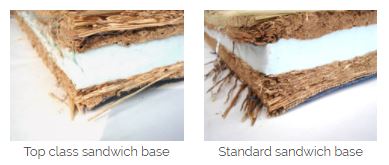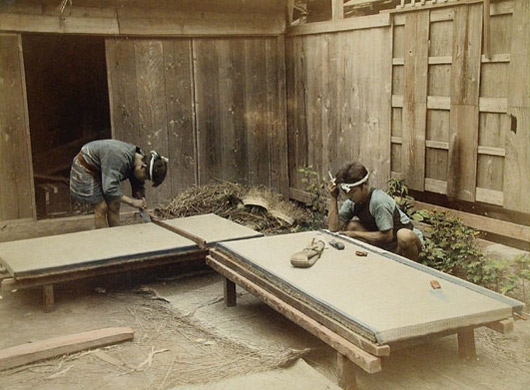Tatami (畳) is one of the most common design elements in traditional Japanese homes along with sliding shoji doors and the tokonoma with hanging scrolls. Tatami mats are dried, woven rushes which are wrapped around and sewn to a core. They are ideal for sitting and sleeping because of the springy but firm texture they provide. Rice straw was the traditional material used for the core, but it has recently been replaced by synthetic materials. Tatami mats are made of rushes which are herbaceous plants of the Juncus species and are known in Japan as “igusa.”
These mats are more fragile and can easily be scratched, gouged, and stained, which makes caring for them more challenging. They also need to be replaced relatively often. Gently used tatami mats can often last under a decade before replacement. The price of these mats are often expensive because of the labor that goes into making them.
Despite the price and need for extra care, tatami mats have a charm and personality that are beloved by the Japanese people. They carry a distinct smell that is sweet and strong but not too heavy.
History of Tatami
Simple straw mats known as “mushiro” have been used in Japan as far back as the Jomon and Yayoi era. It wasn’t until the Nara period that the word tatami was mentioned. The word tatami comes from the verb ‘tatamu’ (畳む) which means to fold or stack on account of how the straw mats were folded-up or rolled during earlier times but has since been stacked in more modern forms today.
During the Nara or Heian periods, tatami was used as a bedding item that showed a person’s status of authority. They used to represent an aristocrat’s level of superiority and this was even reflected in the border designs of each individual mat. Tatami became more mainstream during the Muromachi and Edo periods where it was found in almost all Japanese homes and had lost its sense of superiority. Tatami was used as an essential element in the tea ceremony during the Edo period giving it a historical significance.
What Are the Parts of a Tatami?
The tatami is made of three layers: doko (base), omote (cover), and heri (border).
The doko or base is traditionally made of wara-doko or multilayered 100% natural rice straw. This is considered the best material and has been used for centuries. It gives superior control of humidity, fireproof ability, thermal insulation, durability, and resilience. Styro-doko is another material used that is sandwiched between the straw. It has a similar feel to the natural base but is lighter. Kenzai-doko is base made from building materials and are non-natural. They can be made of either compressed wood-chips, polystyrene foam sandwiched between boards, or all board.


The omote or cover is normally graded, and the highest rated materials go into sacred places like shrines and temples. These premium covers are made from igusa of a certain length, quality, and weave and from a thick, strong mat. Mats made for most Japanese homes are rated as high to mid-grade. Various materials are used in the weave and this determines the strength and durability of the omote. Hemp is the ideal material for this because it provides the strongest and most durable weave.
The heri or border can be made from cotton or hemp but nowadays synthetic fiber is the material most commonly used because it is cheaper and stronger. Heri comes in either a single color or with various patterns.
Note that the size of tatami varies in different regions in Japan.
Kyoto – generally measures 0.955 m by 1.91 m and is referred to as Kyōma (京間) tatami.
Nagoya – generally measures 0.91 m by 1.82 m and is referred to as Ainoma (合の間) tatami.
Tokyo – generally measures 0.88 m by 1.76 m and is referred to as Edoma (江戸間) or Kantōma (関東間) tatami.
In terms of thickness, 5.5 cm is average for a Kyōma tatami, while 6.0 cm is the norm for a Kantōma tatami.
What are the Benefits of Tatami?
One of the benefits of igusa found in tatami mats is that they can be effective air purifiers. They have been known to remove the smoky smell of tobacco smoke. Igusa also has a relaxing property because of the vanillin that it contains. This aroma has a soothing effect. The softness of tatami gives it the added ability to absorb sound which make it an ideal material for homes of people who have low tolerance to loud noises.
Tatami is also known to reduce osteoporosis and helps with keeping the back straight reducing the chances of spinal deformities compared to the use of western style beds and furniture. The unique texture that tatami has while walking barefoot on it offers stimuli to the sole of the feet that contribute to healthier brain function particularly in babies and the elderly. Tatami also is easier to land on in the event of a fall compared to harder tiles or concrete flooring.
Unfortunately, demand for tatami mats have been in decline over the past 20 years. Another major concern is that artisans are rapidly aging and have very few successors available to continue the tradition.
Have you tried sitting or sleeping on tatami mats? Please share with us your experience.
Follow us on Facebook to get updated on latest Japanese lessons and articles about Japanese culture.
We also have free lessons on our renewed website, LearnJapanese123.com
Get your original Hanko (Name seal) @ https://japanese-name-stamp.com







